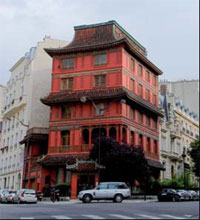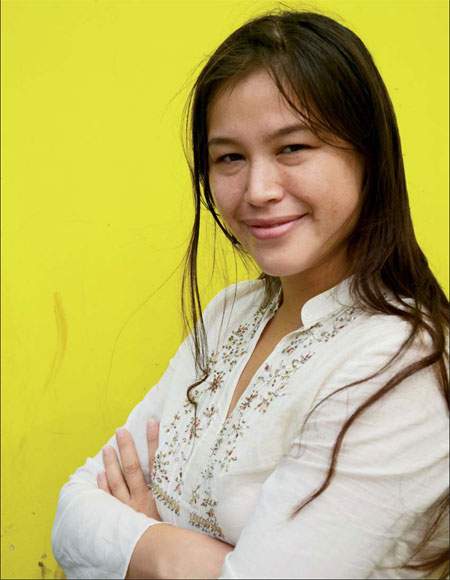Language of art
Updated: 2013-04-05 09:19
By Mark Graham (China Daily)
|
|||||||||||
|
Curator Tiffany Beres specializes in Song Dynasty painting. Left: The former home of art and antiques dealer Loo Ching-Tsai. Provided to China Daily |

Moving to China proved a life-changing experience for Tiffany Beres, who now runs her own art consultancy in beijing
China-based art curator Tiffany Beres has recently completed the most challenging project of her career - organizing a major show at a prestigious new exhibition center in Paris.
The exhibition, L'Asie en Vogue, featured six Asian artists including two from China whose works depict how fashion features in modern life. What made it particularly special was the venue: it was held in the former Paris home of legendary art and antiques dealer Loo Ching-Tsai, which is built in the style of a Chinese pagoda.
The complex, in an up-market area of Paris, close to the Champs-Elysee, has been turned into a private museum that will be used for major exhibitions, and sales, of Asian art, beginning with L'Asie en Vogue.
"We wanted the exhibition to build on C.T. Loo's legacy and take this tradition of art exchange into the West and present it in a really elegant way," says Beres, 29. "They will be shown in the home where he lived, a real architectural marvel in itself.
"It is in its own grounds, a five-story building designed originally as a hotel and transformed by Loo around the 1920s into his residence and gallery. Each of the floors has a different character.
"It is an honor to organize such a groundbreaking exhibition of both traditional and contemporary Asian art there. Embraced by this extraordinary building, these innovative compositions, old and new, explore the historical importance of Asia's traditional craft techniques and the material culture of modern life in a vivid, sensual dialogue."
Loo emigrated from China to Paris early last century and built up a business that obtained works for private collectors and museum curators in Europe and the United States.
Over the years, the dealer amassed up an amazing personal collection of exquisite furniture, porcelain, objets d'art and works of art and antiques from China and other parts of Asia, in addition to 2,000 books and 3,000 art catalogues.
In recent times this architectural and cultural treasure had fallen into disrepair but its acquisition by investors has given new life. After a renovation and refurbishment lasting several years, Pagoda Paris recently reopened, this time as a venue for art exhibitions and sales, with a particular focus on showcasing works from Asia.
Beres, who lives in Beijing and runs her own business, Lotus Art Consulting, was hired to curate the exhibition. The assignment allowed her to utilize a vast network of art and auction-world contacts built up during six years of living and working in China.
The American, whose mother is from Hong Kong, grew up in San Francisco, later attending Brown University before being awarded a Fulbright Scholarship to study in China. After completing studies in the lakeside city of Hangzhou, she moved north to Beijing, working for China Guardian auction house.
"It was at the height of the market and it was my real exposure to the ins and outs of the Chinese collecting world," she says. "I was very happy to have that experience. This is the second part of my life, coming to China and immersing.
"I didn't grow up speaking much Chinese but I did start Chinese painting and calligraphy from the age of four. It was something I was interested in and has stayed with me my whole life. When I went to university I took a course in Chinese art history which really changed my life; Song Dynasty painting is my special area. Having an understanding of art very much adds to your appreciation."
Learning the commercial ropes also gave Beres the confidence to launch Lotus Art Consulting, which obtains works for private collectors and museums. It made her a natural choice to help locate suitable candidates for the L'Asie en Vogue show.
The China artists featured were Li Xiaofeng, known for recycling ceramic shards into dresses; Peng Wei, whose traditional Chinese literati paintings are expressions of femininity related to dress and personal adornment; and Man Fung Yi, whose "woven fashion sentiments" are sculptures knitted with metal threads of stainless steel and brass. Also in the line-up are Kimiko Yoshida from Japan, Ran Hwang from South Korea, Jagannath Panda and Lavanya Mani from India, and Chan Dany from Cambodia.
"I was asked to bring something together that would bring together antique and contemporary, not just China but pan-Asia," Beres says. "We thought of this theme of textiles and costumes, which everyone understands and is familiar with. We worked with a New York collector for the antiquities."
The show attracted art connoisseurs who were lured by the pieces on display and also by the opportunity to browse around Paris Pagoda. The new owners, who are real-estate investors, want the venue to become a major center for showcasing Asian art and culture, as well as being used to host sales and auctions, cocktail receptions, luxury-brand launches, and even movie productions attracted by the striking architecture.
The international co-operation theme is a fitting legacy for an individual who acted as a conduit for such exchanges during an earlier era. Loo, who died in 1957, was famed in the Western world for his deep knowledge of art and antiques, gift for languages, and urbane manner, which allowed him to mix in all social circles.
Collectors were prepared to pay handsomely for Loo to obtain rare works, making him a wealthy man. He also advised many prestigious private and institutional collections, including the Musee Guimet, the Metropolitan Museum of Art, the Freer and Sackler Galleries and the British Museum.
"He was a self-made man who came from China not speaking a word of any other language, learned French and English and went all over the world and was able to set up these bridges," Beres says. "He must have been a very worldly man. He even registered himself at one point as a diplomat in the United States, even though he wasn't, except perhaps a diplomat of culture. He knew how to open doors."
For China Daily
(China Daily 04/05/2013 page28)
Today's Top News
List of approved GM food clarified
ID checks for express deliveries in Guangdong
Govt to expand elderly care
University asks freshmen to sign suicide disclaimer
Tibet gears up for new climbing season
Media asked to promote Sino-Indian ties
Shots fired at Washington Navy Yard
Minimum growth rate set at 7%
Hot Topics
Lunar probe , China growth forecasts, Emission rules get tougher, China seen through 'colored lens', International board,
Editor's Picks

|

|

|

|

|

|






